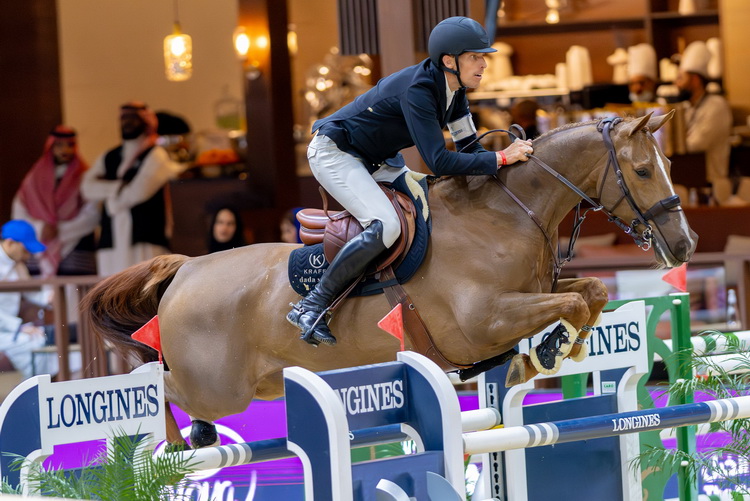
by Nancy Jaffer | Apr 17, 2024
Defending champion Henrik von Eckermann of Sweden and his peerless mount, King Edward, took the first leg of the Longines FEI World Cup Show Jumping Finals in Riyadh, Saudi Arabia, on Wednesday, just as they did last year in Omaha.
“It was a great round today,” the world number one-ranked rider said with a broad smile.

Henrik von Eckermann and King Edward on their way to victory. (FEI Photo)
“It was a much better round than I had in Omaha, even if the result is the same after the first day. It was much more calm. King Edward felt like he jumped amazing from the first jump to the last. and i could do it without chasing.
“I could just keep his big strides going so the course was really my favorite that way.”
The class was a one-round speed affair, with each knockdown adding three seconds to a competitors time. The route was planned by Frank Rothenberger, with Alan Wade as the technical advisor, two gold-standard technicians.

World Cup Course number one.
For young riders with less experience, like 19-year-old Zain Shady Samir of Egypt, it was possible to go around at a careful pace to gain mileage at the top of the sport, trying not to risk a knockdown (he had only one with London Eye, and stands twenty ninth of 34 starters.)
For those who have been there and done that many times at the finals, a daring shortcut and careful planning insured a race around the clock that left the best high in the standings. Henrik’s time of 66.28 seconds was a full 1.12 seconds ahead of his countryman, Peder Fredricson on the aptly named Catch Me Not.
Not surprisingly, Kent Farrington was the best American, tying for fourth on Toulayna with France’s Julien Epaillard (Dubai du Cedre). They both had a time of 69.69 seconds but Kent had a clean round while always speedy Julien had a rail to add 3 to his original clocking of 66.69, which would have put him second if all the poles had stayed in place. They were behind Germany’s third-place Hans Dieter Dreher and the long-strided Elysium (68.49).
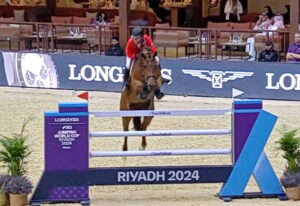
Kent Farrington and Toulayna.
Most of the U.S. contingent was young and riding in their first World Cup Finals. But 19-year-old Californian Skylar Wireman impressed, finishing tenth on Tornado (72.49) with no knockdowns. Another Californian, Jill Humphrey, jumped clean on the U.S.-bred son of Connor, Chromatic BF, in 73.79 seconds.
The Cup continues on Thursday with a time first jump-off test.
Click here for results
Click on this link for point standings
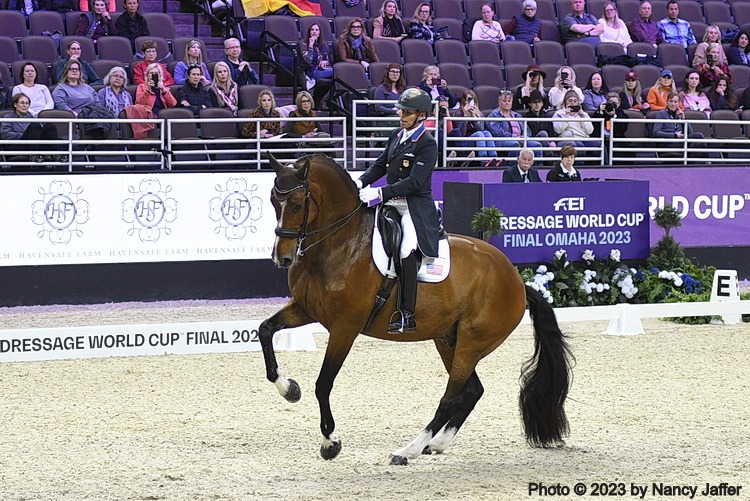
by Nancy Jaffer | Apr 15, 2024
The U.S. dressage Olympic rankings got a good shake-up over the weekend, with candidates competing in shows on both coasts.
Candidates are looking toward being named next month to the eight-member contingent that will ride in European observation competitions prior to selection of the team for the Paris Games. There is one more show left that carries points in both the East and West
Steffen Peters leads with an average of 73.620 after a victories in Del Mar, Calif., on Four Winds Farm’s Suppenkasper, his Tokyo Olympics team silver medal partner.

Steffen Peters and Suppenkasper. (Photo © 2023 by Nancy Jaffer)
The previous leader, 2023 Pan American Games team gold medalist, Sarah Tubman, sank to fourteenth after a difficult show at the World Equestrian Center in Ocala. Her average is now 69.583.
New combinations are on the rise, meanwhile.
Adrienne Lyle stands second and third with Helix (72.655) and Lars van de Hoenderheide (72.259), while Endel Ots is right behind on Zen Elite’s Bohemian (71.764). Adrienne’s horses also are owned by Zen Elite; both she and Endel didn’t start showing them until this year.
Another duo that is new to the show ring, Marcus Orlob and Alice Tarjan’s Jane, stands eighth on 70.060. To read more about Marcus and Jane, simply go to the main story on this website, or click here
Marcus is just ahead of Kasey Perry-Glass, several times the medal-winning teammate of Steffen and Adrienne. She is ninth with Heartbeat W.P. (70.543), the successor to her now-retired veteran, Dublet.
Another West Coaster, Anna Buffini, is fifth with her Fiontini (71.494), while Pan American Games individual bronze medalist and team gold medalist Anna Marek is one place behind in sixth with Janet Simile’s Fire Fly (71.040). She is in Saudi Arabia riding Fayvel in the FEI World Cup Finals this week.
Seventh is Katherine Bateson-Chandler, who seems to have found the key to Jennifer Huber’s Haute Couture (70.935), previously reserve for the 2021 Dutch Olympic team with Dinja van Liere.
by Nancy Jaffer | Apr 9, 2024
In an effort to increase support for equestrian athletes, the U.S. Equestrian Team Foundation has issued “a call to action” geared to 100 days before the start of this summer’s Paris Olympics and Paralympics.
USET Foundation Giving Day, set for April 17, offers an opportunity not only for making financial contributions, but also for spreading awareness and fundraising so the U.S. team can have an impact on the international stage. But response was so good that a match for giving has been extended to April 18.
The cost of sending a team to the Olympics and Paralympics is understandable when you consider that the U.S. is sending 16 horses, with plane fare running $20,000/horse; 16 grooms, four veterinarians, two farriers, two equine physiotherapists and two human physiotherapists, a team doctor,12, 345 pounds of equipment and, oh yes, 16 riders.
It can’t be done without generous contributions.
“Ultimately, this day embodies the spirit of community and generosity, uniting stakeholders behind a common goal of empowering American riders to shine on the global equestrian stage,” a statement from the Foundation emphasized.
The Foundation suggests posting on social media with the hashtags #PathwaytoParis and #USETFoundation GivingDay” to explain why supporting U.S. athletes is important to you. Think of what it costs to get riders, horses and support staff to Paris, as well as to the preparation competitions beforehand that will hone the competitive edge of the U.S. teams.
If you post about Giving Day on line, include this link.
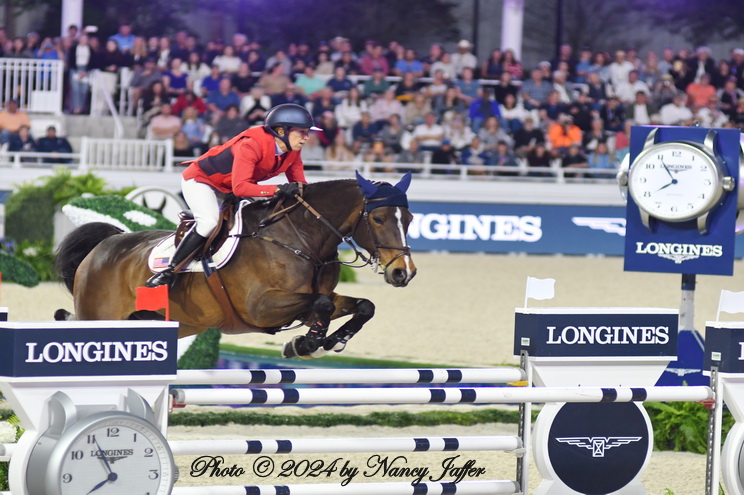
by Nancy Jaffer | Apr 10, 2024
McLain Ward, Kent Farrington, Laura Kraut and Aaron Vale — the U.S. bronze medal team at the Ocala Longines League of Nations competition last month — are among those who have been named to the 10-member U.S. show jumping Olympic short list in preparation for the Paris Games.

Laura Kraut and Baloutinue. (Photo © 2024 by Nancy Jaffer)
The Olympic squad will be chosen from the riders on this list, who will be competing in observation events in Europe, everywhere from the League competitions at St. Gallen, Switzerland, and Rotterdam, Holland, to Aachen. Selection of the team will be made by July 7.

Aaron Vale and Carissimo. (Photo © 2024 by Nancy Jaffer)
McLain’s mounts for the tour include veterans Callas and Contagious, as well as newcomer Ilex (second in the Winter Equestrian Finale last month), and Quimi del Maset, a 10-year-old who is the youngest of that group.

McLain Ward and Callas. (Photo © 2024 by Nancy Jaffer)
Kent is also fielding a four-horse string, with Greya, Landon, Myla and Toulayna in his corner, while Laura has her 2021 team silver Olympic mount Baloutinue, in addition to Bisquetta and Dorado 212. Aaron is riding Carissimo 25.
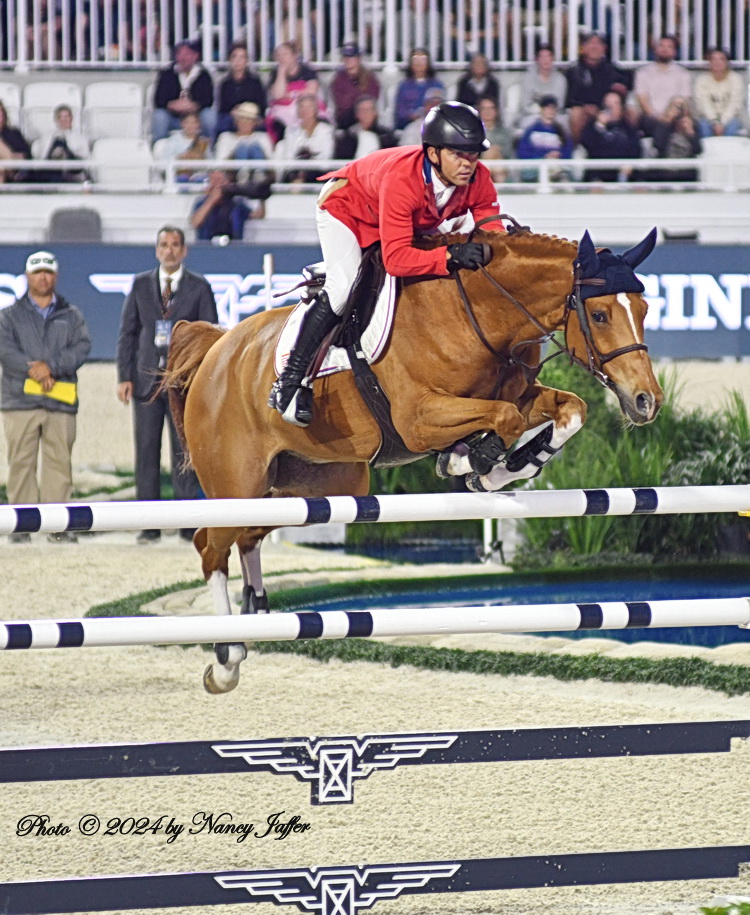
Kent Farrington and Landon. (Photo © 2024 by Nancy Jaffer)
Those names were no surprise. Neither was Karl Cook (Caracole de la Roque and Kalinka Van’t Zorgvliet, who has done a lot of winning in recent seasons. And Callie Schott, who wowed the crowd with a third-place finish in the grand prix last month at the World Equestrian Center, is on the list with Garant, the former mount of Beezie Madden.
Others named are Jessica Springsteen with her 2021 Olympic team silver medal ride, Don Juan van de Donkhoeve; Lillie Keenan (Argan de Beliard and Kick On), Katie Dinan (Out of the Blue SCF) and Natalie Dean (Acota).

by Nancy Jaffer | Apr 12, 2024
A day after winning the Grand Prix for the Freestyle on Thursday with Lars van der Hoenderheide at the World Equestrian Center Ocala, Adrienne Lyle took Friday’s Grand Prix for the Special with Lars’ stablemate, Helix. (73.065 percent).
Then she topped the Special itself with Helix on Saturday, in a narrow victory over Endel Ots and Bohemian, 71.533 percent to 71.021 percent. Bohemian was much more consistent than he was in the Grand Prix for the Special. Like Lars, both those horses are owned by Zen Elite Equestrian.
Discussing Helix, a 12-year-old KWPN gelding, Adrienne assessed him this way: “He is a horse that has incredible try.”
“It’s new riding, new style, a different program, and from the second he got here, he’s so open to letting you mold him however you want to. I’m incredibly impressed with his character.”

Adrienne and Helix in the Grand Prix for Special. (Photo by Andrew Ryback Photography)
In the Grand Prix for the Special, Adrienne’s former teammate, Kasey Perry-Glass, was second on 71.065 percent with Heartbeat W.P. Endel slid into third with 70.782 on Bohemian, who was fourth in the 2021 Olympics when ridden by Denmark’s Cathrine Laudrup-Dufour. Bohemian’s Ocala score was marred by problems in the one-tempis, with marks ranging between 3 and 5.
Katherine Bateson-Chandler now seems to be in sync with Haute Couteur, after coaching from British dressage mastermind Carl Hester. She was fourth with 69.717 percent. In the Special, Katherine moved up to third on 67.447 percent. Kasey was seventh (65.851). To see complete results for the Grand Prix Special, click here.
Things didn’t go so well for Sarah Tubman and First Apple, who have been leading the Olympic Games dressage rankings with an average of 73.469. Until Friday, they hadn’t shown since last fall, when they were on the gold medal team at the Pan American Games.
In the Grand Prix for the Special, Sarah was ninth with 67.587. The combination’s weakest point was the flying change between the pirouettes, with marks of 3 and 4. In the Special itself, she and First Apple had problems with both piaffe and the transition from collected walk to passage/piaffe, finishing 12th of 15 starters on 63.808. While she obviously has lost her lead in the standings, they have not been officially updated so it’s not certain where she ranks.
To read about Friday night’s Freestyle, click here.
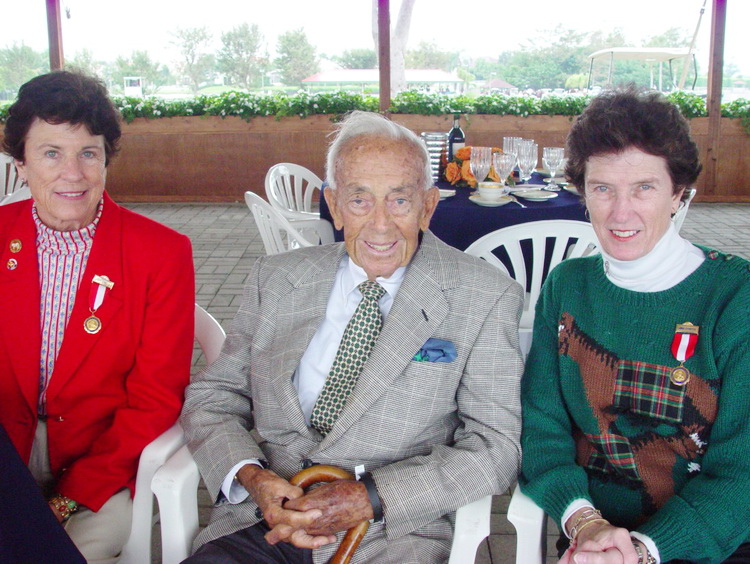
by Nancy Jaffer | Apr 8, 2024
Fran Steinwedell, a fervent supporter of horse sports, passed away Monday.
“She loved her family and was passionate for horses and the show jumping community. She spent much of her life improving our sport for the West Coast,” her daughter, Francie, wrote on social media.
A familiar figure at ringside, Fran supported the quest of another Californian, Anne Kursinski, to go to the Olympics. She bought Livius, Anne’s 1984 Olympic reserve mount who won the Grand Prix of Rome, then invested in Starman, Anne’s team silver medal mount at the 1988 Olympics. In 1996, Anne was aboard Eros, a horse in which Fran and her sister, Carlene Blunt invested. They were able to watch her be part of the silver medal team in that Olympics.

Fran Steinwedell with her sister, Carlene Blunt and longtime horse show manager Honey Craven in 2002. (Photo © 2002 by Nancy Jaffer)
An honorary life trustee of the U.S. Equestrian Team Foundation, Fran was inducted into the Show Jumping Hall of Fame for the hours and contributions she devoted to the sport.
In addition to her sister, survivors include Fran’s three children: Bill and his wife, Barbara; Jim and his wife, Jennifer, and Francie and her husband Richard Carvin; six grandchildren and nine great-grandchildren.

by Nancy Jaffer | Apr 8, 2024
There have been a number of last-minute horse/rider pairings at Grand Prix this season, the latest being Marcus Orlob and Jane, together only for eight weeks.
Last weekend, they won the 3-star Grand Prix Special with 71.894 percent at TerraNova Equestrian Center outside of Sarasota, Fla. Marcus, based in Annandale, N.J., and Jane are fourteenth in the standings for the three-member U.S. Olympic team that will go to Paris this summer. But first things first, and they will have to hustle even to make the top eight who fly to Europe for competition before final selection is made.
“We’re running out of time,” said Marcus, who is showing at the World Equestrian Center in Ocala this week. He finished second Thursday in the Grand Prix for Freestyle with a mark of 69.913. He was behind Olympic medalist Adrienne Lyle and Lars van de Hoenderheide, who won with 72 percent. Third, one point back of Marcus, was Ecuador’s Julio Mendoza Loor and Jewel’s Goldstrike with 68.913. They have already qualified for Paris by virtue of taking individual gold last fall in the Pan American Games.
On Friday night in the cavernous WEC stadium, the tables were turned, with Goldstrike topping an 11-horse field for the Freestyle on 77.55 percent. Experience counts for a lot when riding to music; Julio’s had a techno flair that his performance matched perfectly. He was particularly pleased with the way his horse handled the transition from the canter pirouette to the piaffe.
“I wanted him to stay with me and be with me during the entire test. He did it, and I am very pleased with that,” Julio said, while thanking his wife, Jessica, for her encouragement and support.
Adrienne was second on Lars, less than a point behind Julio, on 76.145 percent. She rode to music previously used by Wizard, her 2012 Olympic mount. It’s a bright medley that runs from “You’ve Lost That Loving Feeling” to the bouncy “Dancing on the Ceiling” and Lars handled it well despite their lack of time together.
Spain’s Pablo Gomes Molina with Ulises de Ymas finished third on 74.315, while Marcus and Jane’s first freestyle performance had some lovely moments to lush music that offered a serenade of strings. They wound up fourth on a respectable 73.890 percent. (For results of the freestyle, click here)

Marcus and Jane doing their freestyle in the stadium.
Marcus and Jane go to TerraNova again for the last qualifying competition at the beginning of May. They made their Grand Prix debut only at the final Wellington, Fla., show last month, but went from fourteenth in the Grand Prix to fourth in the Special over a two-day period there.
Jane had been shown successfully at Intermediate level by her owner, Alice Tarjan, who has been training the Dutchbred daughter of Desperado since she was three.
Together, they won 11 competitions since 2022, but Jane’s Special score with Marcus at TerraNova was the mare’s best percentage ever.
Jane’s personality changes when she gets in the arena. She becomes much stronger, and Alice was still searching for the way to handle that.
“She knows she has a fantastic horse, but she couldn’t connect with her in the show ring,” said Marcus, who is Alice’s trainer.
After a Grand Prix at White Fences near Wellington, Alice told Marcus, “I think at the moment, it’s too much horse for me.”
So Alice suggested that Marcus “put some mileage on her and get her to settle in the ring.”
He replied, “It’s a fantastic opportunity. I don’t say no to it. But I feel like there’s a lot of pressure on me now. It is a super horse. The quality is not even half there yet; there’s so much more in this horse.”
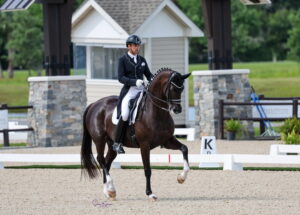
Marcus and Jane at TerraNova. (Photo © by Susan Stickle Photography)
He noted with a chuckle, “Basically, I got pushed right into the water. I wish in general I would have more time. We all know it’s a little bit short notice.”
And now the tables are turned. The student is assisting her trainer.
“I have Alice help me, because she knows the horse inside-out,” said Marcus, explaining she can aid with finding the right tempo and frame for Jane.
In the beginning, he tried to ride more forward to get greater expression in the movements.
“But then, she gets a little too strong and spooky,” Marcus observed.
The next tactic was doing the opposite, trying to “work on relaxation and a little bit more harmony. It seems for now to work better that way.”
He consulted with Christine Traurig, who will be the U.S. chef d’equipe in Paris, and she agreed the way to proceed was, as Marcus recalled her advice, to “go maybe more for a clean test and focus a little bit on the softness and the harmony.”
Once Jane gets in the ring, the power is evident.
“She’s almost like a self-starter,” Marcus observed.
But it “was too much power for Alice. She was basically waterskiing.”
Other new pairings this year, all courtesy of purchases by Zen Elite Equestrian, include Endel Ots with Bohemian and Adrienne not only with Lars, but also Helix. (Read about them at this link.)
But as Marcus pointed out, those horses had loads of international show ring experience and were kept in training by professionals before changing hands. Jane has more of a transition to make. The only Grands Prix she did before Marcus took over were at the National level.

Alice Tarjan and Jane at Dressage at Devon 2022. (Photo © 2022 by Nancy Jaffer)
“That’s the dream, to make the cut (for Europe),” mused Marcus, 42.
Then he wants to “train at home and get to know each other better and focus a little more on expression and each individual movement. But I think at the moment, it’s a little too early. I’m just trying to figure out the changes, pirouettes, the piaffe/passage. She’s a very sensitive mare, which is good, but also very `looky.’ One noise — one person moving from the stands — she looks. So far, it’s quite the journey.”
An advantage he has over the petite Alice is that he is bigger in stature, with longer legs. That means he can use his seat more to get a response from the mare, rather than having to use his hands the way Alice did.
While time is not on his side, progress is being made.
“Each show, I learn something new about her,” he said.
A native of Germany, Marcus came to public attention in 2013 when he rode in the Global Dressage Forum in West Palm Beach, where perennial U.S. team member Steffen Peters (who also grew up in Germany) was working with him.

Steffen Peters and Marcus Orlob at the 2013 clinic in West Palm Beach. (Photo © 2013 by Nancy Jaffer)
“When do you get your U.S. citizenship,” Steffen asked him at the time.
“We really need you.”
Steffen, number two in the 2024 U.S. Olympic rankings, noted back in 2013, “It wouldn’t surprise me if I get to compete with him internationally.”
He may finally have his chance to do that, should Marcus manage to work things out with Jane and achieve his “lofty goal” of finding himself with a ticket to Europe.
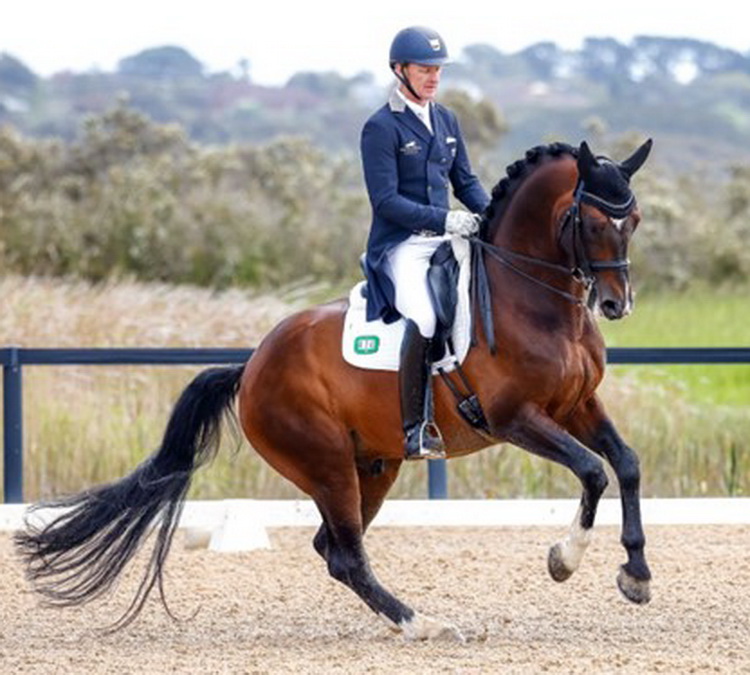
by Nancy Jaffer | Mar 30, 2024
Brett Parbery, once one of Australia’s top 20 bronc riders, will present Dressage at Devon’s popular Masterclass Sept. 26. But don’t worry, he isn’t going to be offering rodeo tips.
His expertise in dressage was demonstrated impressively when guiding Australia’s eventing team to lead the dressage phase at the 2012 London Olympics. He has also competed successfully, finishing tenth in dressage at the 2010 FEI World Equestrian Games.

Bret Parbery (James Abernethy Photography)
His father broke and trained mounts for cattle horse sports. Brett did everything from Pony Club to Polocrosse before focusing on dressage. His eclectic background will enable him to offer pointers to a diverse group of demo riders at Devon, with practitioners of western dressage able to participate along those who ride in the more traditional English competitions.
Brett’s Performance Riders program has an online platform in which horse welfare is the top priority, with horse and rider development as his daily motivation. His training style could be called “Modern Australian,” combining “classical principles with a high-performance sports focus.”
This is the third year of Devon’s Masterclass. Previous instructors were Olympic medalists Sabine Schut-Kery and Cathrine Laudrup-Dufour.
Want to buy tickets? Here’s the link.

by Nancy Jaffer | Apr 4, 2024
The speculation about Salvino’s future is over.
The 17-year-old Hanoverian stallion who was a lynchpin of so many U.S. dressage teams will compete no more. He’s headed for a breeding career in Florida and Colorado.
Owned by Betsy Juliano and ridden by Adrienne Lyle, he had been a part of many successful international efforts, including the 2018 world championships silver medal squad in Tryon, N.C., then the Tokyo Olympics silver medal effort in 2021. In 2022, he was part of the sixth-place world championship team that qualified the U.S. for this summer’s Paris Olympics. He also placed sixth individually in the 2022 world championships and was named the U.S. Equestrian Federation’s International Horse of the Year as Adrienne was voted in as the International Rider of the Year.
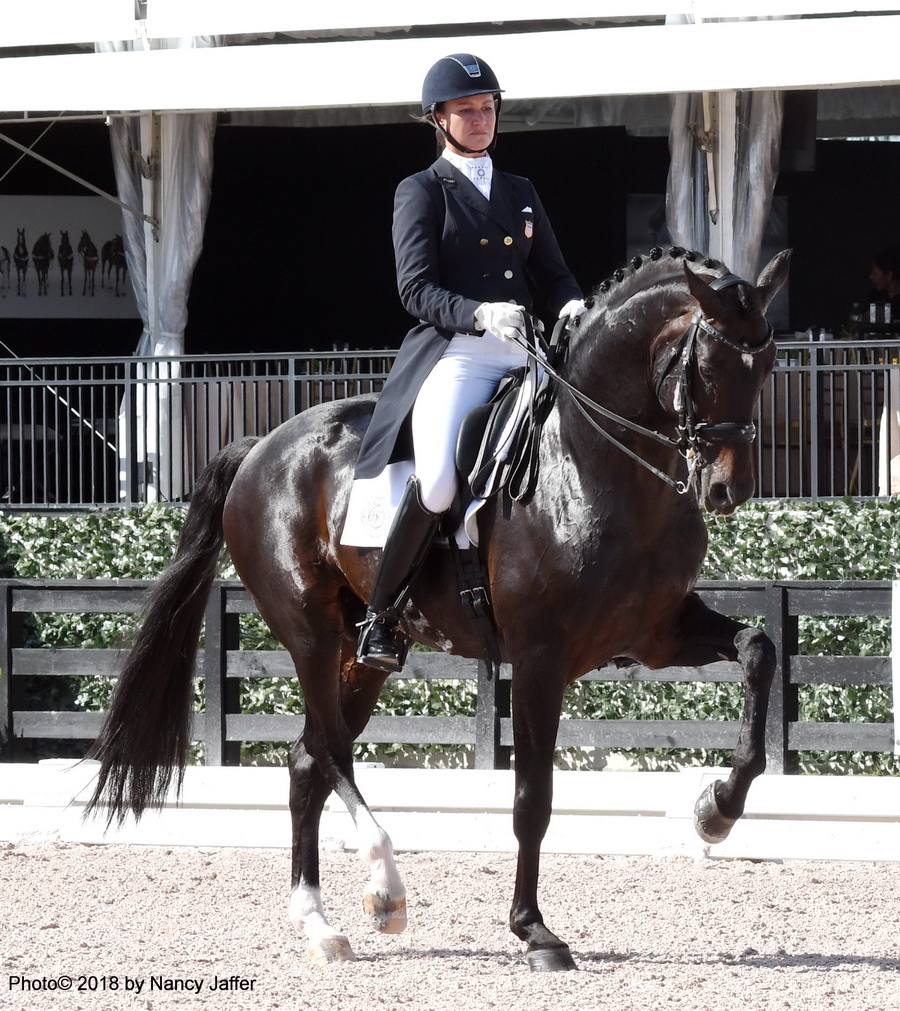
Adrienne and Salvino competing in Wellington. (Photo © 2018 by Nancy Jaffer)
The last time he competed was in January 2023, when he won the FEI World Cup qualifier in Wellington, his fourth victory in a little over a month. Prior to that, he was absent from the arena for four months. Salvino was set to take part in the 2023 FEI World Cup Finals in Omaha until he popped a splint and was withdrawn.
Salvino’s long absence from competition made it seem unlikely he’d be a candidate for Paris, so Thursday’s announcement of his retirement was not unexpected.
Meanwhile, Adrienne is still pointing toward Paris, but with two new horses. She is showing Lars van de Hoenderheide and Helix, owned by Zen Elite Equestrian, with the idea of qualifying for the Games–even though she only got the ride on them earlier this year.
At the TerraNova equestrian center in Florida this weekend, she won both the 4-star Grand Prix for the Special and the Special with Helix. He was marked at 72.021 percent and 73.979 percent respectively in those classes.
Explaining the decision to retire Salvino, Betsy said he is “still quite fit and energetic, but Adrienne and I feel the rigors of the qualifying process, in addition to the leadup to the Olympics would not be in his best long-term interests.”
Adrienne pointed out, “There has always been a great deal of interest in Salvino as a breeding stallion. We feel it’s time to explore this as the next phase of his career. Salvino has far surpassed any expectations we ever had for him.
“This has been a very difficult decision to make, but more than anything we feel it is the right decision for him,” she added.
“He continues to be ridden at home; he loves to work and show the other horses how it should be done. He has given us so much, and Betsy and I are committed to making sure he keeps on living his best life.”
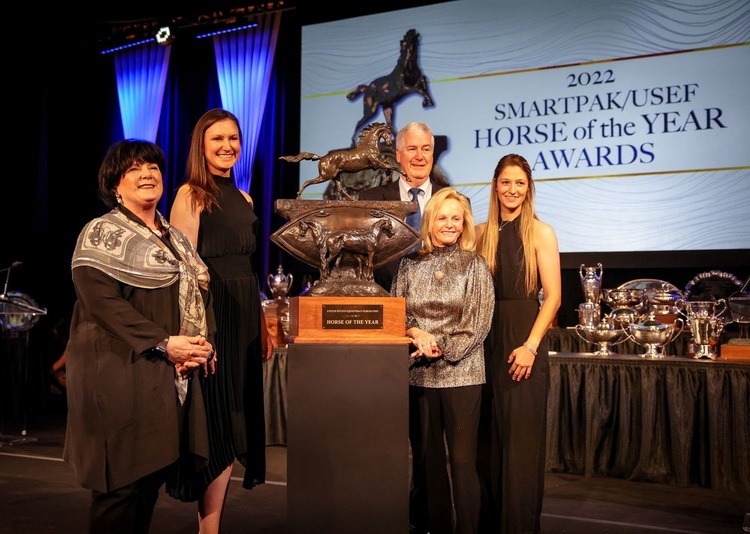
Adrienne Lyle at the 2022 Smartpak USEF Horse of the Year awards with Betsy Juliano, USEF President Tom O’Mara and Adrienne’s mentor, Debbie McDonald. (Photo © 2022 by Nancy Jaffer)
Writing on social media, Adrienne gave her thanks to Betsy and offered this tribute to Salvino: “You are the best friend, teammate and partner anyone could ever have, and you were an absolute warrior in the ring. You had my back every time we went down center line… if I was nervous you took the lead and showed me there was nothing to be afraid of… if I messed up, you picked up the slack and did it right anyway… if I doubted myself, you reminded me that we could make it happen, and when we turned up the final center line and I would whisper under my breath, “Take it home, buddy”… I could always feel you rise another foot off the ground and give it your absolute everything.
She added, “You taught me that if you really believe in something, keep your head down and work until the rest of the world believes in it too. I am so glad I get to still greet your beautiful face every morning and saddle up for fun rides together, for years to come.”
Adrienne began competing Salvino internationally in March 2017. Previously he had been ridden in Young Horse classes by Spanish riders. Originally named Sandronnerhall, the son of Sandro Hit and a Donnerhall mare was rechristened when he came to the U.S. He was purchased in 2015 by a syndicate, of which Betsy was one of the original members. She became the sole owner in 2017.
In her social media post, Adrienne emphasized, “Betsy Juliano, none of this would have been possible without your vision, dream, dedication, and unwavering commitment to Salvino. I am so thankful for your amazing support! And to Debbie McDonald for the years of expert guidance and help. None of this would have been possible without such an amazing team.”

Adrienne Lyle and Salvino in the Grand Prix Special.
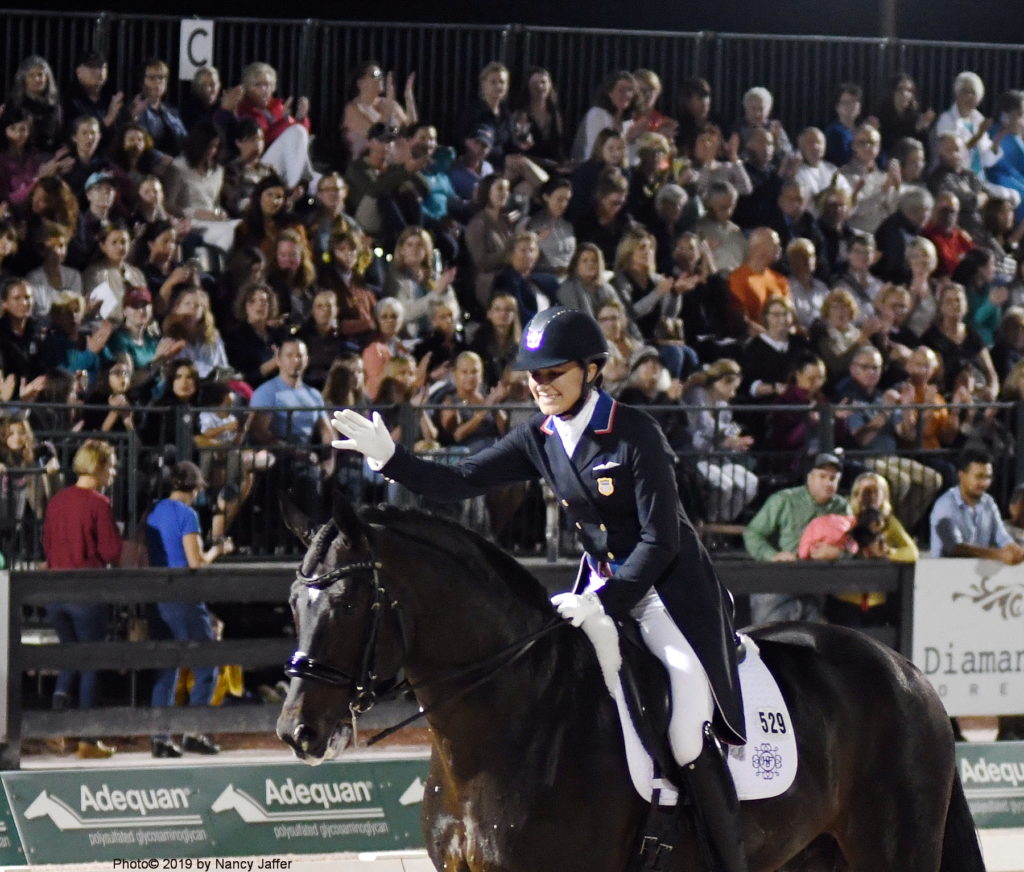
Salvino and Adrienne were always crowd favorites. (Photo © 2019 by Nancy Jaffer)
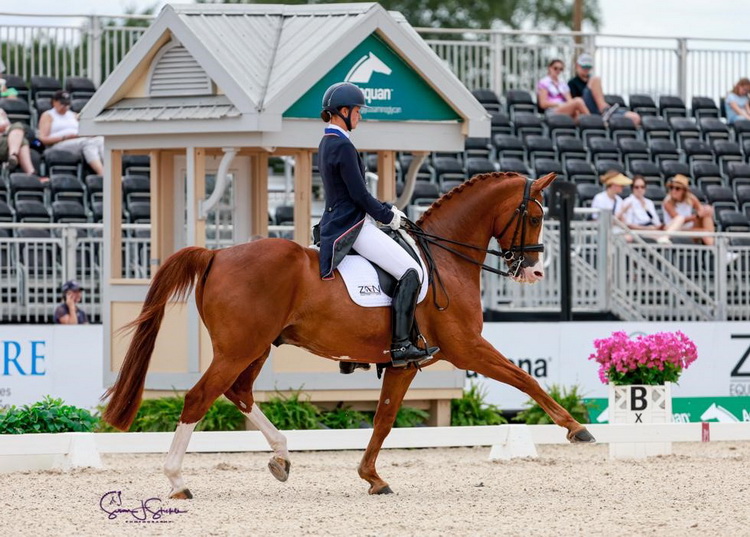
by Nancy Jaffer | Mar 30, 2024
In only her second international competition with Lars van de Hoenderheide, Olympic veteran Adrienne Lyle won the 3-star Grand Prix Special at the Adequan Global Dressage Festival with a mark of 73.192 percent on Saturday.
She bested the winner of Thursday’s Grand Prix, Endel Ots, who was second on Zen Elite’s Bohemian with 72.490 percent. Both horses are owned by Zen Elite’s Heidi Humphries.

Adrienne and Lars. (Photo © SusanJStickle.com)
Third went to Adrienne’s longtime teammate, Kasey Perry-Glass, back in action after a long absence from the international level with a 71.383 percent on Heartbeat W.P.
Marcus Orlob of Annandale, N.J., finished fourth on Jane, previously shown by her owner, Alice Tarjan. Their score was 70.830 percent.
Adrienne said, “I think it’s 10 weeks now that we’ve had Lars and this is the first full Special I’ve ridden through on him. I’m so incredibly happy at his energy and his honesty and his willingness. It seems like he’s starting to understand what I want and fight for me in there, which is really special in such a new relationship.”
Saying, “I was really happy with his piaffe/passage tour,” Adrienne added, “I got a bit braver to make the piaffe stay on the spot more and feel like I could trust that more. His canter tour is always super; he’s got super power and the changes are just a treat to ride.”
Adrienne observed, however, “just because we have a timeline” as she looks toward Paris, she is not planning to increase her horses’ work more than the usual four days a week maximum. She also rides Helix, second in the qualifier, for Elite Equestrian.
Heidi Humphries, the owner of Elite Equestrian “has such an amazing vision,” Adrienne noted.
Bohemian was ridden to fourth place in the Tokyo Olympics by Denmark’s Cathrine Laudrup- Dufour. He subsequently had a Korean rider and then Endel took over late last year.
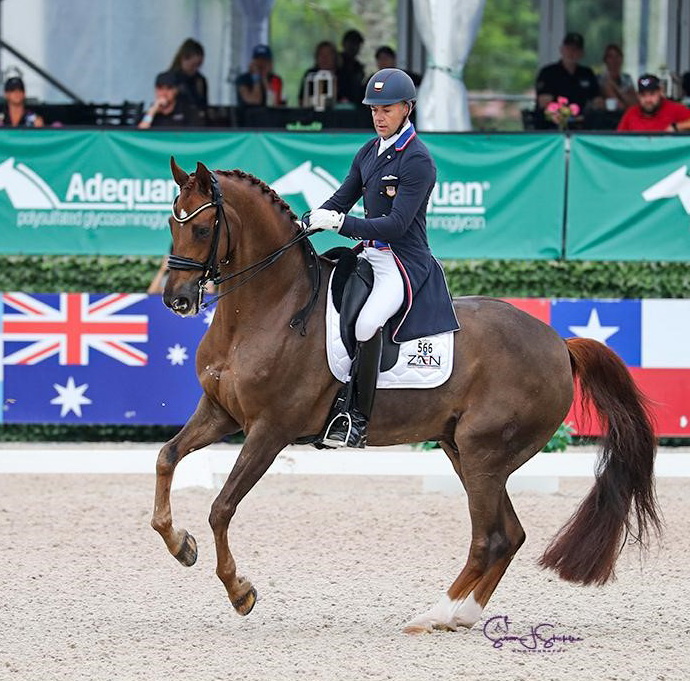
Endel Otts and Bohemian. (Photo © SusanJStickle.com)
Endel, who had not ridden in an international Grand Prix before Thursday, was marked at 72.761 percent in the Grand Prix qualifier, ahead of Helix (71.065). Adrienne was placed first by one judge in that class.
Adrienne, who is coached by her mentor, Debbie McDonald, also was third with Lars (70.652) in the qualifier.
In the Grand Prix, Bohemian had a problem in the two-tempis, with one judge giving him a mark of 2 and the other four judges marking him at 3, which brought his score way down. That was balanced by the fact that he had mostly 8’s in piaffe and passage. In the Special, his problems cropped up in the one-tempis, with marks between 4 and 6 from the five judges. The piaffe and passage continued to be his strong points.
“It’s all very surreal,” Endel said after his ride in the Grand Prix.
“You always see all the famous people like Adrienne Lyle and Kasey Perry and I am just thankful and happy to be in there with them and part of the group.”
He called Bohemian “a crazy cool horse.”
These horses will have to qualify if they are to be considered for a U.S. European tour, which is the precursor for Olympic selection. Although the Global festival ends this weekend, shows at TerraNova in Myakka City and the World Equestrian Center in Ocala are offering qualifiers next month.
In Saturday’s 4-star Special, Katherine Bateson-Chandler won with Haute Couture on 71.872 percent. Her coach, British star Carl Hester, came to the U.S. to train her for this show.
“We’ve had our stumbling blocks that were really mentally tough for both of us, so it took a lot of regrouping,” said Katherine, citing “a big mountain to climb.” She is hoping to be invited compete with the U.S. contingent in Europe later this spring.
The mare was ridden in the Tokyo Olympics by the Netherlands’ Dinja van Liere. Haute Couture was purchased for Katherine by her friend, Jennifer Huber.
Click here for 3-star Special results.
Click here for 4-star Special results.

























